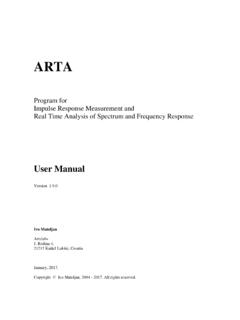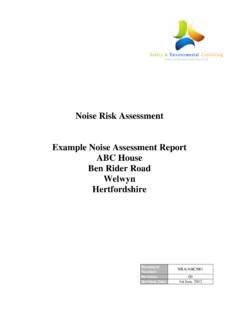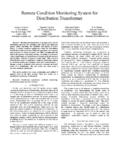Transcription of ARTA User Manual - artalabs.hr
1 ARTA Program for Impulse Response Measurement and Real Time Analysis of Spectrum and Frequency Response user Manual Version Ivo Mateljan Artalabs J. Rodina 4, 21215 Ka tel Luk i , Croatia January, 2017. Copyright Ivo Mateljan, 2004 - 2017. All rights reserved. ARTA user Manual 2 Content 1 INTRODUCTION .. 5 REQUIREMENTS .. 6 Soundcards .. 6 MEASUREMENT SETUP .. 9 A FIRST TOUCH .. 12 AUDIO HARDWARE SETUP .. 14 WDM Audio Driver Setup for Windows 2000 / XP .. 15 WDM Audio Driver Setup for Windows Vista / 7 / 8 / 10 .. 17 ASIO Driver Setup .. 19 CALIBRATION .. 20 Calibration of Soundcard Output Left Channel .. 20 Calibration of Soundcard Input Channels .. 21 Calibration of the Microphone .. 21 Frequency Response Compensation .. 21 ROTATING TURNTABLE DRIVER SETUP .. 23 External .exe file driver .. 23 Internal driver for Outline turntable ET 250-3D .. 23 Testing of turntable driver.
2 24 GETTING IMAGES OF GRAPHS AND WINDOWS .. 24 2 SPECTRUM ANALYZER .. 25 Souncard testing .. 25 THE SPECTRUM ESTIMATION PROCEDURE .. 29 Spectrum Averaging .. 31 Signal Windowing .. 32 Spectrum Graph Setup .. 33 Graph Colors and Grid Style Setup .. 34 FREQUENCY RESOLUTION OF DFT AND OCTAVE-BAND ANALYZERS .. 35 RMS LEVEL .. 38 THE TIME RECORD .. 39 MONITORING SPECTRA OF WIDEBAND SIGNALS .. 41 THE PERIODIC NOISE .. 43 TESTING WITH TWO SINE SIGNAL .. 45 Intermodulation distortion definitions .. 46 THE MULTITONE TESTING .. 48 MONITORING MEASUREMENT DYNAMICS .. 49 SPECTRUM OVERLAY .. 49 SAVING GENERATOR SIGNALS IN A .WAV FILE .. 51 3 THEORY OF THE FREQUENCY RESPONSE MEASUREMENTS .. 52 LTI INPUT/OUTPUT RELATIONSHIP .. 52 DUAL CHANNEL SYSTEM WITH CONTINUOUS NOISE EXCITATION .. 54 DUAL CHANNEL SYSTEM WITH PERIODIC NOISE EXCITATION .. 55 SINGLE CHANNEL SYSTEM FOR FREQUENCY RESPONSE ESTIMATION .. 57 4 REAL-TIME FREQUENCY RESPONSE MEASUREMENT.
3 58 user INTERFACE FOR REAL-TIME MEASUREMENT OF FREQUENCY RESPONSE .. 58 DYNAMIC RANGE IN FREQUENCY RESPONSE MEASUREMENTS .. 61 FR OVERLAYS .. 63 GETTING IMPULSE RESPONSE FROM MEASURED FREQUENCY RESPONSE .. 65 SYSTEM DELAY 68 PIR FILES .. 69 PIR file format .. 69 PIR file export and import .. 70 Export of (spatial group) of frequency responses .. 71 ARTA user Manual 3 5 IMPULSE RESPONSE MEASUREMENT AND SIGNAL RECORDING .. 72 IMPULSE RESPONSE MEASUREMENT WITH PERIODIC NOISE EXCITATION .. 72 IMPULSE RESPONSE MEASUREMENT WITH SWEPT-SINE EXCITATION .. 74 IMPULSE RESPONSE MEASUREMENT WITH MLS EXCITATION .. 76 IMPULSE RESPONSE MEASUREMENT WITH EXTERNAL EXCITATION AND TRIGGERED RECORDING .. 78 TRIGGERED SIGNAL RECORDING .. 79 Triggered signal recording with external excitation and spectrum estimation .. 79 Triggered signal recording with internal signal and trigger generation .. 81 BASIC EDITING PROCEDURES .. 82 6 SYSTEM ANALYSIS FROM IMPULSE RESPONSE.
4 84 GATED IMPULSE AND FREQUENCY RESPONSE .. 84 Gated Impulse Response .. 84 Gated Frequency Response .. 87 Minimum Phase, Group Delay and Phase Intercept Distortion .. 90 Managing Overlays .. 91 Editing Smoothed Frequency 93 Low Frequency Loudspeaker Box Diffraction Scaling .. 94 Repeated Measurement .. 95 Simultaneous Measurement of Frequency Response and Harmonic Distortions .. 95 STEP RESPONSE .. 98 IMPULSE RESPONSE ENVELOPE (ETC ENERGY TIME CURVE) .. 100 CUMULATIVE SPECTRUM .. 102 Cumulative spectral decay .. 102 Short-time Fourier transform .. 106 BURST DECAY WITH A PERIOD BASED TIME SCALE .. 107 Classical Sine-burst Testing .. 107 The Importance of the Period Based Time Scale .. 108 Wavelet Analysis for the Fast Estimation of Bursts Decay Envelopes .. 109 Procedure for Obtaining the Burst Decay Graph .. 109 Comparison of Burst Decay Graphs and CSD Graphs .. 111 Time-frequency Resolution .. 114 7 ESTIMATION OF ROOM ACOUSTICAL PARAMETERS.
5 115 ISO 3382 PARAMETERS .. 115 ACOUSTICAL ENERGY DECAY .. 122 SPATIAL ACOUSTICAL PARAMETERS .. 125 Early Lateral Energy Measures .. 125 Interaural Cross Correlation - IACC .. 125 Measurement of Spatial Parameters .. 127 Estimation of Spatial Parameters from Previously Measured Impulse Responses .. 128 8 SPEECH 129 MTF MODULATION TRANSFER 129 SPEECH TRANSMISSION INDEX .. 130 STI AND %ALCONS .. 133 9 TOOLS .. 135 DIRECTIVITY PATTERNS .. 135 Basic Definitions .. 135 Types of Directivity Patterns in ARTA .. 135 Creation of Directivity Patterns in ARTA .. 139 Format of DPF files .. 143 Automatic recording of spatial group of impulse responses .. 144 Exporting (spatial group) of frequency responses .. 145 INTEGRATING SPL MEASUREMENTS AND DATA LOGGING .. 147 Basic Definitions of an Integrating SPL meter .. 147 Working with ARTA SPL-Meter .. 150 OCTAVE BAND SPL METER AND NOISE RATING .. 153 Noise Rating in Buildings.
6 156 ARTA user Manual 4 THIRD OCTAVE BAND SPL AND LOUDNESS METER .. 160 A Zwicker Loudness Model .. 163 THIRD OCTAVE SPL AND LOUDNESS TIME RECORD .. 164 TWO-CHANNEL VOLTAGE LEVEL METER AND THIRD OCTAVE ANALYZER .. 166 LITERATURE .. 169 APPENDIX - MENUS, TOOLBARS AND SHORTCUTS .. 172 ARTA user Manual 5 1 Introduction The ARTA is a program for impulse response measurement, real-time spectrum analysis and real-time measurement of the frequency response. It is a tool for acoustical measurements and "point to point" testing of the audio quality in communication systems. The ARTA has functions of following measurement systems: 1. Impulse response measurement system with signal generators: periodic white noise, periodic pink noise, MLS, linear and logarithmic swept-sine. 2. Dual channel Fourier analyzer with signal generators: white noise, pink noise, periodic white noise and periodic pink noise. 3. Single channel Fourier analyzer with signal generators: periodic white noise and periodic pink noise.
7 4. Spectrum, octave band and THD analyzer with signal generators: sine, two sine, multitone, white noise, pink noise, periodic white noise and periodic pink noise. 5. Triggered storage scope with gated spectrum analysis and short-time Fourier transform. 6. Two-channel voltage level meter and third octave analyzer. Note: Mode 2 and 3 can be also used for the estimation of the impulse response. With calibrated microphone, ARTA can be used as virtual IEC class 1 SPL meter with real time modes: 1. Integrating SPL meter with 24 hours data logging, 2. Octave SPL meter with noise rating (NR, NC, PNC, RC, NCB), 3. Third octave SPL meter with report of specific loudness, loudness in sone and loudness level in phone. The ARTA is also a powerful analyzer of: 1. Gated frequency response, 2. Smoothed frequency response (in 1/n-octave bands), 3. Step response, 4. Impulse response envelope (ETC curve), 5. Cumulative spectrum and burst decay waterfall curves and sonograms, 6.
8 Energy decay in reverberant environments, 7. Room acoustical parameters 8. Speech intelligibility measures: MTF, STI, RASTI, %AL. 9. Loudspeaker directivity pattern ARTA user Manual 6 Requirements Requirements to use ARTA software are: Operating systems: Windows XP / Vista / 7 / 8 Processor class Pentium, clock frequency 600 MHz or higher, memory 256MB for Windows 2000/XP or 2MB for Vista/Windows 7/8 Full duplex soundcard with synchronous clock for AD and DA converters WDM or ASIO soundcard driver (ASIO is trademark and software of Steinberg Media Technologies GmbH). The installation of this software is simple: Take the ARTA setup program or just copy the files " " and " " to some folder and make a shortcut to " ". All registry data will be saved automatically at the first program execution. Files with extension ".PIR" are registered to be opened with ARTA. They contain the data of the periodic impulse response (PIR) or signal time record.
9 Results of other types of measurements (frequency response and spectrum) may be saved in ASCII formatted file, or as an overlay file. ARTA can export and import file in various formats (.wav, .tim and .txt). The ARTA does not dump graphs to the printer, instead of this all graphs could be copied to the Clipboard and pasted to other Windows applications. Soundcards The ARTA has been used successfully with all soundcards that has WDM or ASIO driver. The compatibility with different operating system versions is driver dependent. Soundcards are classified into three groups: standard sound systems that are incorporated in the computer motherboard, add-on sound cards for PCI or ISA bus, sound systems that connects to the computer USB or Firewire interface. XLR- female XLR male TSR 6,3mm and mini TSR 3,5mm TS 6,3mm and mini TSR 3,5mm RCA chinch pin1 ground pin 2 - plus pin 3- minus pin1 - ground pin 2 - plus pin 3- minus T (tip) - plus R (ring) - minus S (sleeve) - ground T (tip) plus S (sleeve) - ground pin - plus guard - ground balanced microphone cables balanced microphone cables balanced cables or unbalanced stereo cables unbalanced cables (coaxial cable) unbalanced cables (coaxial cable) Table Connectors and cables used in audio systems Depending of the target user group, soundcards differs in type of input/output connectors and necessary cabling.
10 Basic characteristics of connectors and cabling are given in Table ARTA user Manual 7 Standard PC soundcards uses stereo cables and mini-TSR connectors (Fig. ). Semi-professional high quality soundcards use RCA chinch connectors and unbalanced connections (Fig. ). Professional soundcards use TSR mm connectors for balanced connection, TS mm connectors for unbalanced connection, and XLR (Cannon) connectors for balanced microphone connections (Fig ). 1. Line-In (light blue) 2. Line-Out Front speaker (green) 3. Mic In - Mono microphone (pink) 4. Out Central speaker and Sub-bas (orange) 5. Out-Back speaker (black) 6. Out Side speaker (grey) Figure Audio connectors on the PC motherboard (example for 5+1 surround sound system). Standard PC stereo systems have three connectors (1, 2, and 3 on the motherboard). Surround 5+1 sound systems have additional three connectors (4, 5, and 6 on motherboard). One of outputs is designed to drive a headphone with nominal 32 impedance.











